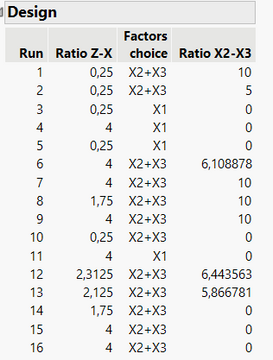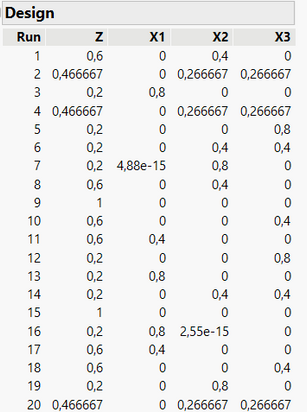- Subscribe to RSS Feed
- Mark Topic as New
- Mark Topic as Read
- Float this Topic for Current User
- Bookmark
- Subscribe
- Mute
- Printer Friendly Page
Discussions
Solve problems, and share tips and tricks with other JMP users.- JMP User Community
- :
- Discussions
- :
- JMP Doe with multiple mixtures
- Mark as New
- Bookmark
- Subscribe
- Mute
- Subscribe to RSS Feed
- Get Direct Link
- Report Inappropriate Content
JMP Doe with multiple mixtures
Hi,
Asking for help with setting up a DOE.
Z and X are components of a mixture, each individual factor ranging from 0.2 to 0.8 and together summing to 1. There are three different types of X, X1 X2 and X3. X2 and X3 can be used alone or combined together in a ratio, however, they cannot be combined with X1. I tried to summarise this in the excel sheet below.
Thanks in advance!
- Mark as New
- Bookmark
- Subscribe
- Mute
- Subscribe to RSS Feed
- Get Direct Link
- Report Inappropriate Content
Re: JMP Doe with multiple mixtures
Hi @NWolfe,
Welcome in the Community !
To help you further, can you please provide more informations about :
- What is your goal ? Optimize a mixture, find the most significant factors to improve a response ?
- Are all the ingredients necessary (for example, Z should always be in the formulation) ? Can the amount change, because in your example, Z is always at 0,2 for example ? Or in the case of X2 and X3, should they be always together (or not, based on your image) ?
- What are the reasons behind these constraints ? Are these constraints necessary because the responses can't be measured in these area ? Or is it just based on experience/domain expertise ? Is there a physical impossibility to realize these experiments or not ?
- Are you supposing a particular model (main effects, interactions, ... ? Scheffé Cubic, other ?) ?
- What is your maximum experimental budget ?
- ...
Other Community members may think of other questions to answer, these are the first ones I see for your use case that really matters to help you find and create a suitable design.
"It is not unusual for a well-designed experiment to analyze itself" (Box, Hunter and Hunter)
- Mark as New
- Bookmark
- Subscribe
- Mute
- Subscribe to RSS Feed
- Get Direct Link
- Report Inappropriate Content
Re: JMP Doe with multiple mixtures
Since the design seems to always involve pairs of factors, like Z with X (X1 or X2+X3) and X2 with X3, I'm not even sure you need mixture factors or a mixture design.
With the constraint you have, you could define 2 numerical continuous factors, ratio Z/X and ratio X2/X3, and a categorical factor "X choice" with two levels : X1 and X2+X3.
Adding a constraint with the "Disallowed Combinations filter" like "If X1 is chosen, then ratio X2/X3 can't be >0" could lead you to a design respecting your constraints :
Factors choice == "X1" & "Ratio X2-X3"n >= 0.0001(And if ratio X2/X3 = 0 and factor choice is set on X2+X3, that means you only have X3 and Z in your formulation, with the ratio between the two defined by the factor ratio Z/X).
This might clearly not be a clean design and a nice way to proceed further (don't skip the questions from my 1st post please), but just wanted to highlight that even if you have mixture factors, depending on the settings of your study you might end up with a design with non-mixture factors.
"It is not unusual for a well-designed experiment to analyze itself" (Box, Hunter and Hunter)
- Mark as New
- Bookmark
- Subscribe
- Mute
- Subscribe to RSS Feed
- Get Direct Link
- Report Inappropriate Content
Re: JMP Doe with multiple mixtures
Hi Victor, thank you for your reply.
- What is your goal ? Optimize a mixture, find the most significant factors to improve a response ?
- The goal is to find the most significant factors from which we can optimize the formulation and understand how these factors are affecting the desired output.
- Are all the ingredients necessary (for example, Z should always be in the formulation) ? Can the amount change, because in your example, Z is always at 0,2 for example ? Or in the case of X2 and X3, should they be always together (or not, based on your image) ?
- Yes, all the ingredients are necessary - Z is always in the mixture but can change from 0.2-0.8, X2 and X3 can mix together but not with X1.
- What are the reasons behind these constraints ? Are these constraints necessary because the responses can't be measured in these area ? Or is it just based on experience/domain expertise ? Is there a physical impossibility to realize these experiments or not ?
- This is based on experimental practice.
- Are you supposing a particular model (main effects, interactions, ... ? Scheffé Cubic, other ?) ?
- I was planning on Scheffe Cubic for mixture, incl. secondary interactions.
- What is your maximum experimental budget ?
- Can run up to 30 experimental runs.
- Mark as New
- Bookmark
- Subscribe
- Mute
- Subscribe to RSS Feed
- Get Direct Link
- Report Inappropriate Content
Re: JMP Doe with multiple mixtures
Hi @NWolfe,
Thanks for the reply.
As factors in a mixture design are not independent from each other (mixture components sum up to 1), this constraint introduces correlations among the parameter estimates. This correlation inflates the standard errors of the parameter estimates, which in turn reduces the power and make it more difficult to screen and assess statistical significance of mixture factors.
There are some designs that can help (D-optimal mixture designs, ABCD designs), but you will still have difficulties in assessing statistical significance for the parameters in the model. You can still assess relative practical importance of your factors by looking and comparing the parameters estimates.
There might be several options to create an optimization mixture design with your constraints:
- Model-based Mixture design : Start with a Custom (D-optimal) Design, add the mixture factors with their ranges, and specify in the model main effects and some 2-factors interactions : none between X1 and X2 or X1 and X3 if you want X1 and X2/X3 to not be mixed in any formulation experiment. This type of design will look like this (example with 20 runs here, you can change the number of runs, and you can of course round up the extremely low value like 4,88e-15 to 0) :
Here is the script to generate the design :
DOE(
Custom Design,
{Add Response( Maximize, "Y", ., ., . ), Add Factor( Mixture, 0.2, 1, "Z", 0 ),
Add Factor( Mixture, 0, 0.8, "X1", 0 ), Add Factor( Mixture, 0, 0.8, "X2", 0 ),
Add Factor( Mixture, 0, 0.8, "X3", 0 ), Set Random Seed( 550059023 ),
Number of Starts( 4436 ), Add Term( {1, 1} ), Add Term( {2, 1} ),
Add Term( {3, 1} ), Add Term( {4, 1} ), Add Term( {3, 1}, {4, 1} ),
Add Term( {1, 1}, {2, 1} ), Add Term( {1, 1}, {3, 1} ),
Add Term( {1, 1}, {4, 1} ), Add Term( {1, 1}, {3, 1}, {4, 1} ),
Set Sample Size( 20 ), Optimality Criterion( "Make D-Optimal Design" ),
Simulate Responses( 0 ), Save X Matrix( 0 ), Make Design,
Set Run Order( Randomize ), Make Table}
)- Model-agnostic Mixture design : Since you mention optimization, another possible option could be to consider Space-filling Mixture design with your constraints. This type of design does not assume any model before the analysis, so you have some flexibility about the modeling, from "standard" regression models (with different complexities) to Machine Learning models like SVM, Gaussian Process, Neural Networks... If this option is interesting for you and you would like to have an example for your case, I can also propose a possible Space-filling design.
I hope this first answer will help you,
"It is not unusual for a well-designed experiment to analyze itself" (Box, Hunter and Hunter)
Recommended Articles
- © 2026 JMP Statistical Discovery LLC. All Rights Reserved.
- Terms of Use
- Privacy Statement
- Contact Us



